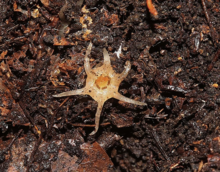| Relictithismia | |
|---|---|

| |
|
Scientific classification
| |
| Kingdom: | Plantae |
| Clade: | Tracheophytes |
| Clade: | Angiosperms |
| Clade: | Monocots |
| Order: | Dioscoreales |
| Family: | Burmanniaceae |
| Genus: |
Relictithismia Suetsugu & Tagane [1] [2] [3] |
| Species: | R. kimotsukiensis
|
| Binomial name | |
| Relictithismia kimotsukiensis | |
Relictithismia kimotsukiensis is a species of fairy lanterns, in the family Thismiaceae. [1] [2] [3] It is the only species in the genus Relictithismia. [1] [2] [3] This mycoheterotrophic plant is known only from the Kimotsuki Mountains, in the Ōsumi Peninsula, Kagoshima Prefecture, Kyushu Island, in the southern Japan. [1] [2] [3] The species is assessed as Critically Endangered based on IUCN Guidelines. [1] The genus is characterized from the closely related Haplothismia by its solitary flowers, having an annulus, and anther thecae largely separated, whereas in Haplothismia the 2-6 flowers are borne on pseudoracemes, without annulus, and the anther thecae are connate. [1] [2] [3]
Etymology
The genus name is derived from the combination of Latin words "relictus", meaning "left behind", and the generic name " Thismia", whereas the species name "kimotsukiensis" refers to the type locality of the species, Mt. Kimotsuki. [1] [2]
Distribution
This species is known only form the type locality in the Kimotsuki Mountains, in the Kagoshima Prefecture, Kyushu Island, in southern Japan. [1] [2] [3]
Phenology
Flowering individuals, as well as individuals with immature fruits were observed and collected in the month of June. [1]
References
- ^ a b c d e f g h i j k Suetsugu, Kenji; Nakamura, Yasunori; Nakano, Takafumi; Tagane, Shuichiro (2024-02-29). "Relictithismia kimotsukiensis, a new genus and species of Thismiaceae from southern Japan with discussions on its phylogenetic relationship". Journal of Plant Research. doi: 10.1007/s10265-024-01532-5. hdl: 20.500.14094/0100486392. ISSN 1618-0860.
- ^ a b c d e f g h Pskhun (2024-03-01). "Species New to Science: [Botany • 2024] Relictithismia kimotsukiensis (Thismiaceae) • A New Genus and Species from southern Japan with discussions on its phylogenetic relationship". Species New to Science. Retrieved 2024-03-02.
- ^ a b c d e f g Suetsugu, Kenji; Nakamura, Yasunori; Nakano, Takafumi; Tagane, Shuichiro (2024-02-29). "Relictithismia kimotsukiensis, a new genus and species of Thismiaceae from southern Japan with discussions on its phylogenetic relationship". Journal of Plant Research. doi: 10.1007/s10265-024-01532-5. hdl: 20.500.14094/0100486392. ISSN 1618-0860. PMID 38421521.
| Relictithismia | |
|---|---|

| |
|
Scientific classification
| |
| Kingdom: | Plantae |
| Clade: | Tracheophytes |
| Clade: | Angiosperms |
| Clade: | Monocots |
| Order: | Dioscoreales |
| Family: | Burmanniaceae |
| Genus: |
Relictithismia Suetsugu & Tagane [1] [2] [3] |
| Species: | R. kimotsukiensis
|
| Binomial name | |
| Relictithismia kimotsukiensis | |
Relictithismia kimotsukiensis is a species of fairy lanterns, in the family Thismiaceae. [1] [2] [3] It is the only species in the genus Relictithismia. [1] [2] [3] This mycoheterotrophic plant is known only from the Kimotsuki Mountains, in the Ōsumi Peninsula, Kagoshima Prefecture, Kyushu Island, in the southern Japan. [1] [2] [3] The species is assessed as Critically Endangered based on IUCN Guidelines. [1] The genus is characterized from the closely related Haplothismia by its solitary flowers, having an annulus, and anther thecae largely separated, whereas in Haplothismia the 2-6 flowers are borne on pseudoracemes, without annulus, and the anther thecae are connate. [1] [2] [3]
Etymology
The genus name is derived from the combination of Latin words "relictus", meaning "left behind", and the generic name " Thismia", whereas the species name "kimotsukiensis" refers to the type locality of the species, Mt. Kimotsuki. [1] [2]
Distribution
This species is known only form the type locality in the Kimotsuki Mountains, in the Kagoshima Prefecture, Kyushu Island, in southern Japan. [1] [2] [3]
Phenology
Flowering individuals, as well as individuals with immature fruits were observed and collected in the month of June. [1]
References
- ^ a b c d e f g h i j k Suetsugu, Kenji; Nakamura, Yasunori; Nakano, Takafumi; Tagane, Shuichiro (2024-02-29). "Relictithismia kimotsukiensis, a new genus and species of Thismiaceae from southern Japan with discussions on its phylogenetic relationship". Journal of Plant Research. doi: 10.1007/s10265-024-01532-5. hdl: 20.500.14094/0100486392. ISSN 1618-0860.
- ^ a b c d e f g h Pskhun (2024-03-01). "Species New to Science: [Botany • 2024] Relictithismia kimotsukiensis (Thismiaceae) • A New Genus and Species from southern Japan with discussions on its phylogenetic relationship". Species New to Science. Retrieved 2024-03-02.
- ^ a b c d e f g Suetsugu, Kenji; Nakamura, Yasunori; Nakano, Takafumi; Tagane, Shuichiro (2024-02-29). "Relictithismia kimotsukiensis, a new genus and species of Thismiaceae from southern Japan with discussions on its phylogenetic relationship". Journal of Plant Research. doi: 10.1007/s10265-024-01532-5. hdl: 20.500.14094/0100486392. ISSN 1618-0860. PMID 38421521.
